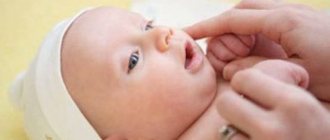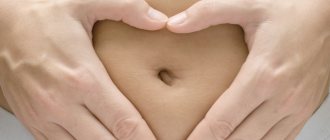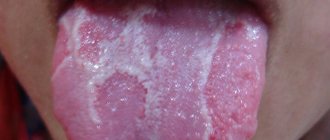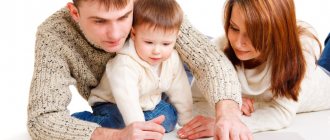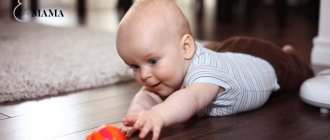YOU MAY ALSO LIKE
Newborn development
Placing a newborn on his tummy: why is it so important?
This may come as a surprise to you, but newborn reflexes are responsible for most of your baby's reactions and movements. When you lift your baby and he bends his legs, it’s a reflex. When your baby turns his head when you stroke his cheek, this is also a reflex. Babies are born with a set of reflexes, some of which last for several months (for example, the spoon-throwing reflex) and some that disappear after a few weeks (the Moro reflex). In this article you will learn about the unconditioned reflexes of a newborn and how long they last.
Searching reflex of newborns
The search reflex helps a newborn baby find the nipple during the first feeding. It occurs in response to stroking the cheek or corner of the mouth - the child turns his head in the direction of irritation and opens his mouth. At first, your baby may turn his head to and from the nipple, but by three weeks of age he will have learned to turn his head in the right direction to latch onto the nipple (or bottle nipple).
Sucking reflex
The sucking reflex appears in the baby even before birth. Sometimes during an ultrasound you can see the baby sucking his thumb while still in his mother’s belly. After birth, once your nipple is in your baby's mouth, your baby will start sucking automatically. If you bottle feed your newborn with formula or expressed breast milk, this reflex occurs in response to the bottle's nipple. In fact, sucking is a very difficult skill for a newborn to master. And although the sucking reflex is innate, some babies do not immediately learn to suckle correctly. But over time they master this skill.
Diagnostic purposes
The study of the proboscis reflex has the following goals:
- Determination of development norms . The proboscis reflex manifests itself in a newborn from the first day of life and indicates the fullness of its development. Accordingly, by testing this reflex, the doctor can conclude that the baby complies with physiological standards.
- Assessment of the neurological status of the newborn . If certain injuries occur during childbirth, the brain stem may be damaged. In such babies, unconditioned reflexes are impaired. In most cases, the proboscis symptom begins to appear by the seventh day of life, and before that it is weakly expressed or absent altogether. Based on the results of diagnosing this reflex in combination with other indicators, the neurologist assesses the child’s neurological status. What is significant in this case is the duration of the absence of manifestation of the reflex and its intensity.
- Determination of pathologies in a child . Normally, the reaction to touch in the form of pulling the lips into the proboscis disappears after the second or third month of life. If this reaction is present in the fourth month or later, this may be evidence of the presence of certain organic brain lesions. Pathology may also be indicated by the presence of a certain asymmetry of the lips when pulled into a tube or the complete absence of this reaction in the first 2-3 months of life. It should also be noted that cases of persistence of this reflex up to one year, and sometimes up to two or three years, as a protective-adaptive reaction, were also observed in healthy children.
- Detection of pathologies in adulthood . With normal development, the absence of pathologies and developmental deviations, it is not typical for an adult to display infantile reflexes, since there is no need for them. On neurological examination, a positive proboscis reflex in adults may raise suspicion for stroke, encephalopathy, traumatic brain injury, or bulbar syndrome. The reaction can also be diagnosed with pseudobulbar palsy or indicate diffuse brain damage. In healthy people, this reflex can be moderately expressed in old age.
Moro reflex
The Moro reflex, or startle reflex, appears in the first month of a child's life. You can trigger the reflex by hitting the table on which the child is lying with your hand (at a distance of 15 cm from the child’s head), or by a sudden noise. In response, the baby spreads his arms, unclenches his fists and straightens his bent legs. After a few seconds, the hands return to their original position. At the same time, the baby may cry. This is how the Moro reflex manifests itself, one of the reflexes of newborns, which is usually well expressed until the fourth or fifth month.
Main causes of flinching
But phase changes are not the only reason why children may startle in their sleep. It should be understood that the child’s emotions and the functioning of his nervous system, reflexes - all this is interconnected and is not yet controlled by the baby. Therefore, any experiences during the day, dreams during the superficial phase, and peculiarities of the nervous system lead to the fact that the newborn can sleep quite restlessly. And chaotic movements of the arms and legs in this case are accompanying. If your child constantly sleeps like this, you can consult a neurologist, but it is quite possible that you should just monitor your activities before bedtime. Typically, such violent expression of emotions during sleep stops by the age of five. This is explained by the fact that it is during the rapid phase that the brain develops, and by this age the maturation process ends.
There are other reasons that make babies wince in their sleep:
- intestinal colic;
- fatigue;
- teething;
- urination;
- sharp sounds.
Obviously, among the listed reasons there are no diseases that would require prompt examination. Colic is a natural phenomenon for children in the first months of life. As a rule, when they occur, the baby tightens his legs, cries, and if they begin in his sleep, he may shudder.
A newborn gets very tired of many curious relatives, new impressions, even games. That is why the baby should not play tricks or be too active before going to bed. By the way, dreams are also a manifestation of new emotions, although they say that even in the womb, babies already see dreams.
All other reasons are as natural as the transitions between phases of sleep. But don't let your guard down.
Reflex smile
In the first month of your baby's life, you may notice him smiling in his sleep. This is a reflexive smile - a response to an internal stimulus in a dream. This is not a real smile yet. You may have to wait a little while before your baby smiles consciously for the first time. At 2 months, your baby may begin to smile at you when he is awake, for example when you make faces or tickle him. This is no longer a reflexive, but a conscious smile. All parents can’t wait to see this cheerful, sincere smile. Be patient, it will be worth the wait!
Grasp reflex
Stroke your baby's palm and you will feel him wrap his fingers around your finger, and if you lightly press on your baby's foot, he will curl his toes. This is how the grasping reflex manifests itself. Thanks to this reflex, a child can hold a rattle in his tiny hand. But do not forget that this is an unconscious reaction and just one of the unconditioned reflexes of a newborn. Your baby can open his hand and let go of your finger at any time, so you don’t need to lift it while he’s holding on to your fingers. The upper grasp reflex (palms) begins to fade at 3–6 months. The lower grasp reflex (foot) usually lasts up to 4–8 months.
Three Basic Human Reflexes
Immediately after birth, the child has three protective reflexes given to him by nature:
- Yanking. For any injection, the child must withdraw his leg or arm.
- Pupillary. Bright light always causes the pupil to constrict.
- Nictitating. If you blow into a newborn's face, he immediately squints his eyes.
These three basic reflexes, generously given to a person in the very first seconds after his birth, protect him throughout his entire life and do not leave him until his very last days.
Reflex of support, straightening and automatic walking
If a newborn baby is taken under the arms and raised so that his feet are in contact with the surface, he will begin to move his legs, as if walking on air. This is how the support and automatic walking reflex manifests itself. Remember that for now this is an unconditioned reflex of the newborn, and not a sign of readiness to go. You will need to be patient to wait for the joyful moment when your baby takes his first steps.
Briefly about the reflexes of newborns and infants
This table lists the reflexes that are observed in newborns. Keep in mind that children develop at different rates, so the age at which a particular reflex fades may vary.
| Reflex | When appears | When it fades |
| Reflex smile | From birth | 2 months |
| Moro reflex | From birth | 2-4 months |
| Automatic walking reflex | From birth | 2-4 months |
| Search reflex | From birth | 4 months |
| Spoon pushing reflex | From birth | 4–5 months |
| Fencer reflex | From birth | 4–6 months |
| Superior grasp reflex | From birth | 3–6 months |
| Inferior grasp reflex | From birth | 4–8 months |
Watching how reflexes are gradually replaced by conscious movements and reactions is very interesting, and in general it’s joyful to see how your baby develops and changes right before your eyes.
How this article was written The information presented in this article is based on expert advice published by trusted (medical and government) sources such as the American Pediatric Association and the American College of Obstetricians and Gynecologists. A complete list of links to sources used to write this article can be found at the end of the article. The information on this page is not a substitute for professional medical advice. Always consult your doctor for diagnosis and treatment.
Simonov's classification: convenient and understandable
The famous Russian scientist P. V. Simonov proposed his simple and understandable system for classifying human innate reflexes.
He divided all unconditioned reflexes into three types:
- Vital.
- Reflexes of given roles.
- Reflexes of independent development.
Let us try to understand what the essence of each type is and why this particular classification has become so popular in the world?
Vital are all those reflexes that are directly related to the preservation of human life itself. Let's list them:
- Food.
- Defensive.
- Effort saving reflex. For example, if the result of actions is expected to be the same, then a person always chooses the one that takes the least amount of effort from him.
- Reflex that regulates sleep and wakefulness.
Here it is especially important to understand a simple truth: if any of the listed needs are not satisfied in time, then the life of a living organism ends immediately. This is the fundamental difference between innate and conditioned reflexes.
To implement any of these reflexes, a person does not need another person. This is their main difference from role reflexes, which can only be accomplished through contact with another person, but not alone.
Role reflexes include parental and gender. The last group of “self-development reflexes” includes:
- Reflex game.
- Researcher reflex.
- Copy reflex.
